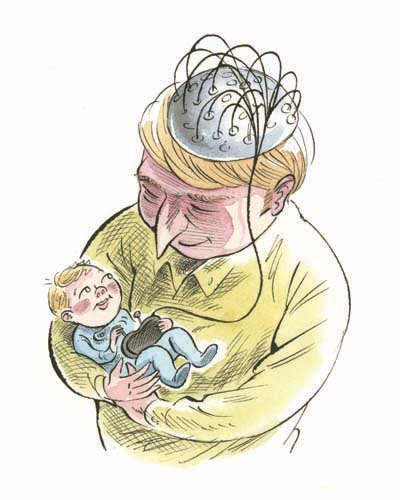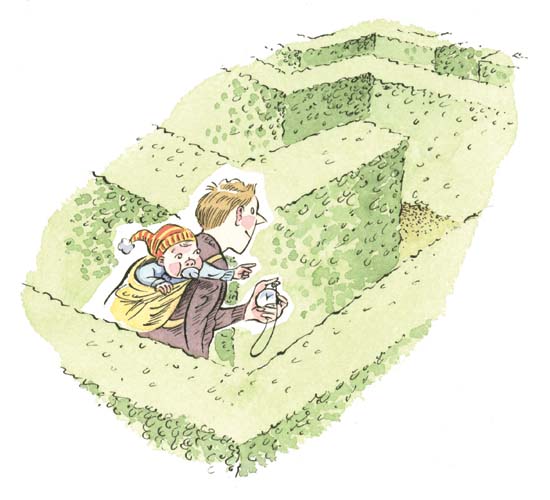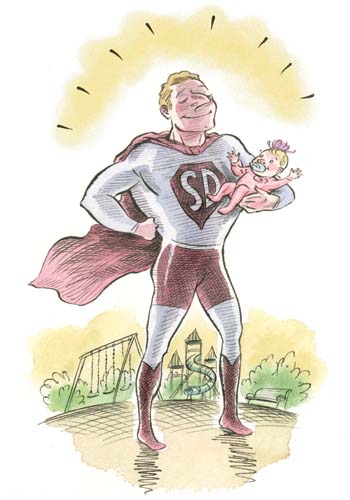Ask any new parent: Taking care of a newborn is a physical and emotional marathon — and the pace only begins to slacken with kindergarten. It may not be so surprising that the hormonal surges of pregnancy and childbirth endow mothers with some extra oomph to help them through. Studies have shown that their senses become sharper, and they’re more resilient and more motivated. These changes in the brain take place because many hormones — testosterone, estrogen and prolactin among them — also act in the brain to regulate its functions and help it react to change in the environment.
New research on mice, rats, monkeys and humans shows that, while men don’t endure the pangs of childbirth, they get some of the same cognitive and physical benefits. Loving a woman and fathering her children changes a man’s body and brain in ways that make him more canny and resourceful, while improving his ability to handle stress. At the same time, living with the woman he loves alters a man’s hormones and neurochemistry to make him a better mate.

But to take full advantage of the biochemistry of fatherhood, society may need to change both its parental leave laws and its stereotypes about fathers who nurture.
Craig Kinsley and Kelly Lambert led research into the positive changes in the brains of female rats who were pregnant or recent mothers; their findings were documented in Katherine Ellison‘s 2005 book, The Mommy Brain. Now they’ve turned their attention to daddies and found that rats that father litters also get smarter at finding food and less stressed in new situations.
Lambert, chair of the psychology department at Randolph-Macon College, is using a National Science Foundation grant to study the paternal circuits in the brain of the male California deer mouse. Lambert calls this monogamous and highly paternal creature “Mr. Mom.” Once a male mates, he hangs around the nest whenever he’s not out foraging to feed the family, grooming the babies and keeping a close eye on them.
It makes sense that pregnancy could remodel a female’s brain; Lambert wants to understand what drives similar changes in the male’s. Lambert tests for paternal behavior by placing a baby mouse under a plastic cup and then placing a male in the cage with it. The more paternal a mouse is, the harder he’ll try to rescue the pup. Deer mice that had fathered litters were a lot more persistent than the bachelors.

“We looked at their brains, and there was more activation in the problem-solving areas in the good dads, as if they were more engaged in actively trying to solve the problem of getting the pups out,” Lambert says. Similar changes in a man’s brain could improve job performance (as well as make it easier to set up the Wii).
But these changes aren’t automatic. Lambert has found that simply exposing a male deer mouse to baby mice — even if they’re not his own — is enough to trigger growth in the parts of his brain involved in motivation and problem solving. Lambert’s theory is that there are circuits in the brains of paternal species that are activated by the sight and sounds of wriggly pups.
“There’s some brain circuit there for parental behavior,” Lambert says. “Layers of the brain are activated when they’re drawn or motivated to care for another animal.”
Approximately 3 percent of male mammals provide what’s known as biparental care — that is, both father and mother cooperate in raising offspring. Many go through hormonal changes that seem to facilitate the switch from swinger to clinger. Male marmosets gain weight during their mates’ pregnancy, and 15 percent or more of human males experience symptoms of pregnancy along with their partners in what’s known as couvade.
According to ongoing research on monkeys, Mr. Mom syndrome could be the result of the male brain becoming more sensitive to vasopressin, a neurochemical whose activity is enhanced by testosterone. Vasopressin is important in a male’s bond with his mate, and it also plays a role in alertness and aggression.
“I think of vasopressin as something that promotes the animal being active, brave and investigating things,” says Karen Bales of the University of California, Davis. Bales has found changes in the brains of male titi monkeys after they mate that are similar to those charted by Lambert and Kinsley. Titis are a highly monogamous species, and couples spend most of their days side by side, tails twined together, with their offspring clinging to the male.
Bales has found significant differences in the areas of the titi brain thought to be responsible for motivation, reward and sexual response before and after they mate. She also saw changes in the supraoptic nucleus of the hypothalamus, the part of the brain that produces vasopressin. Activation of these parts of the brain in titis, as in mice, adds up to increased motivation and better problem solving.
Vasopressin is also a physical tonic. In a recent paper, Bales and her colleague, Michael Jarcho, report that vasopressin mellows out the stress response. In male titi monkeys — and likely in human males, as well — vasopressin is released during sex. So the regular sex that comes with marriage might keep a man from suffering stress-related ills like high blood pressure. At the same time, it helps him power through his daily challenges.
Testosterone is another piece of the puzzle that we could call “the daddy brain.” Peter Gray, a professor of anthropology at the University of Nevada, has been working with an international team of scientists to understand how a man’s neurochemistry changes as he mates and settles down. His studies have found that married men have lower levels of testosterone, the hormone that makes them randy and roaming. Another study of human couples, pre- and postnatal, found that men had higher levels of prolactin and lower levels of sex steroids after the baby was born. Prolactin is known as the hormone of lactation, but it also seems to influence a new father’s responsiveness to his baby’s cries, while dads with lower levels of testosterone are more sympathetic to their babies and more motivated to respond to them.

This hormonal shift also makes it more likely that a father will be around to help out with the kids, Gray posits. When a man is trying to find a mate, testosterone gives him the drive to go after a woman he fancies, as well as to hold his own if he has to compete with others for her attention. But once he’s won her, this same fire would make it harder for him to settle down.
“Mate seeking and parenting are a trade-off,” Gray says.
But these hormone changes don’t necessarily mean that married sex has to be cooler. While the monogamous and highly paternal tamarind monkey shows a drop in testosterone when its mate gives birth, it’s as enthusiastic about sex as ever. Moreover, women can pick out high-testosterone guys just by looking at photos — and they rate them as poor husband material.
The testosterone drop could be triggered by the odor of a man’s children — not the smell of dirty diapers but minute amounts of hormones on the skin or breath of the newborn. When scientists at the Wisconsin National Primate Research Center separated marmoset dads from their families and then gave them a whiff of scent from their babies’ genital areas, their testosterone levels dropped within 20 minutes.
Understanding how fatherly nurturing of the young gets triggered should provide some encouragement to new dads who take one look at their squalling bundles of red and say, “Eeou.” Fatherly love may take time to grow. After all, mom’s body and brain have enjoyed a nine-months-long stew of hormones to prepare her for this role, while the overhaul of dad’s brain seems to begin only at the appearance of the child.
As Lambert says, “We may be more predisposed to fathering than some species, but there still is a learning curve.”
To maximize the physical changes that support parenting, the best thing a prospective father can do is take an active role in birth preparations and be physically close to his partner and their child when the baby is born, snuggling close and inhaling that unique baby smell. Research by Jay Fagan, a professor of social work at Temple University, shows that fathers who get involved in pregnancy seem more committed to their partner and the child after it’s born.
But society makes it hard for both parents to share child care, especially in this time of economic turmoil. The Family and Medical Leave Act provides mothers and fathers up to 12 weeks off work to care for a newborn. This is far from a universal benefit, however. The act covers public agencies, schools and companies with more than 50 employees; in 2000, only 42.2 percent of male workers were eligible, according to the U.S. Department of Labor. Moreover, the act provides for unpaid leave, making it nearly impossible for dual-income and low-income families to take much time off.
“Men tend to make more money than women do. When push comes to shove, if anybody is going to stay home at all, it’s the person with lower income,” Fagan says.

The evolutionary strategy of co-parental care of offspring increases their chances of survival: One parent forages while the other protects nest, den or cave. Even today, there’s a societal benefit to two-person households. According to the U.S. Census Bureau, children in homes without a father are five times more likely to be poor than those whose fathers live with them; fatherless kids are also more likely to be injured in a serious accident. All told, the National Fatherhood Initiative estimates the annual public costs of U.S. fathers’ absence from their families at $100 billion.
Change may be on the horizon. California, New Jersey and Washington already mandate paid leave, and federal workers recently won four paid FMLA weeks off. Several bills that were working their way through Congress at the end of the Bush administration sought to provide some paid leave, and during his 2008 presidential campaign, Barack Obama promised to expand FMLA coverage while helping fund state programs.
Paid family leave is only part of the prescription for taking full advantage of the Mr. Mom phenomenon. Fagan’s research has shown that to excel in fatherhood, fathers need education in childbirth, newborn care, early child development and the role of the father, starting before birth and lasting into the first three years of the child’s life.
For fathers to reach their potential, sexual stereotypes — the male as breadwinner and the female as sole nurturer — also have to change so stay-at-home dads aren’t seen as unmanly Mr. Moms but virile Super Dads.
Sign up for our free e-newsletter.
Are you on Facebook? Become our fan.




